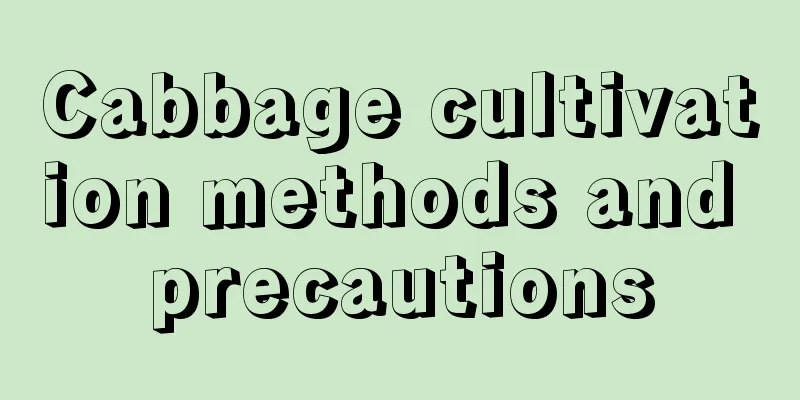Cabbage cultivation methods and precautions

1. Maintenance methods1. Soil: Growing cabbage has very high requirements on soil fertility and requires the soil to have a high humidity. It is suitable to be planted in fertile soil with good drainage. 2. Light: Cabbage prefers light and is suitable to be planted in places with good light. Insufficient light will seriously affect the yield of cabbage, but certain protective measures should be taken in summer to avoid burning the leaves. 3. Temperature: Cabbage prefers a mild climate, and the seeds are most suitable for germination at eight to ten degrees. It is best to control the temperature between 10 and 22 degrees during the growing period. When it exceeds 30 degrees, it will not be suitable for its growth. When the temperature is below 5 degrees, frost damage is likely to occur. 4. Water: Cabbage should be watered more frequently. The soil needs to be kept moist during the growing period. It is best to have no water accumulation on the surface, but there should be no water shortage. Sufficient water is an important factor in ensuring high yield. 2. Breeding techniques1. Sowing: Direct seeding is generally adopted, with row seeding as the main method and on-demand seeding as the auxiliary method. Before sowing, you need to select plump seeds. Some varieties have a low germination rate, so you must choose carefully. After selecting the seeds, they should be sown in time and the soil should be kept moist after sowing. 2. Summer: Summer is the main season for cabbage growth. The temperature should be controlled below 30 degrees, because if the temperature is too high, it will stop growing and its yield will be affected to a certain extent. 3. Problem diagnosis and treatment1. Disease: Cabbage is prone to soft rot, which usually occurs during the heart stage and causes rot. When it appears, it must be removed in time, and then sprayed with medicine for timely treatment. In addition, water should be irrigated reasonably to ensure sufficient moisture. 2. Pests: Spodoptera litura is a common pest that will eat the surface of the plant. In severe cases, it will eat up all the leaves. It should be treated in time. Insects should be eliminated as much as possible in the early stages of an infestation to avoid problems later. IV. Other issues1. Is it poisonous? Cabbage is a common vegetable and is edible. You can consider planting some in the open space at home. It is also easy to manage. 2. Can it be planted in the ground: Cabbage is generally planted around July and August, mainly in open space. Attention should be paid to regular fertilization and irrigation, and attention should also be paid to preventing the occurrence of diseases. |
<<: Cultivation methods and precautions of Zisun ball
>>: Cultivation methods and precautions of Da Cangjiaodian
Recommend
How to improve the survival rate of Christmas cactus grafting
Grafting time should be timely If you want to inc...
How to prepare coconut soil and coconut bran to make nutrient soil (optimal ratio)
Coconut soil preparation requirements The most co...
How many years can blue snowflakes be kept
1. How many years can it be raised? Blue snow flo...
What plants should be placed in the living room to bring wealth and good health to the whole family?
1. Lucky Bamboo Lucky bamboo itself is very beaut...
When is the cutting of wood fragrance flower
1. Which month to take cuttings The cuttings of o...
Are the leaves of your green radish turning yellow? It turns out that these “3” positions should not be used for placement. Check to see if you’ve fallen into this trap!
The most common green plants in the home should b...
The growing environment of avocado is suitable for the conditions of the growing place
Avocado Growing Environment and Conditions Avocad...
If you are tired of raising green plants, it is better to raise a pot of "Purple Bamboo Plum". Don't worry about it, the branches and leaves will grow wildly
Well, today Huahua will not disappoint the sincer...
Can plants be watered with Coca-Cola? How to water plants with Coca-Cola
Can plants be watered with Coca-Cola? Plants can ...
Can mangosteen be grown in Guangxi?
Can mangosteen be grown in Guangxi? Mangosteen ca...
When is autumn wheat harvested?
Autumn wheat is generally wheat harvested in autu...
Can I eat the aloe vera I grow at home? How can I eat it?
1. Introduction Aloe vera belongs to the monocoty...
Which month is suitable for planting dry rice?
When is dry rice planted? Upland rice is mainly p...
What is the medicinal value of monk fruit?
1. Relieve cough and reduce phlegm The ingredient...
What is the flower language of Cleome
1. Flower Language The flower language of the but...









